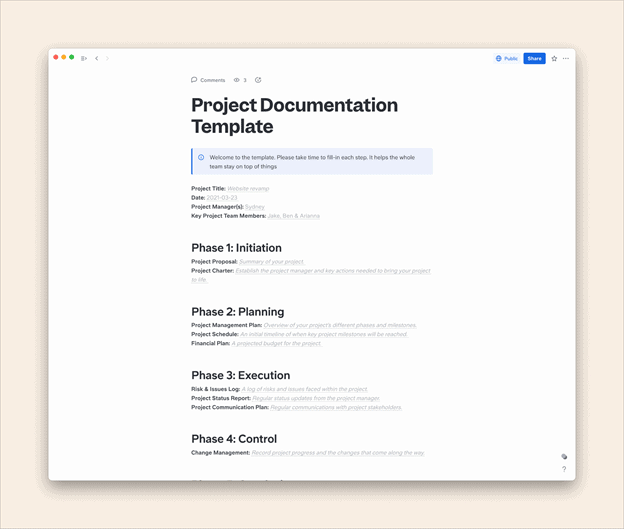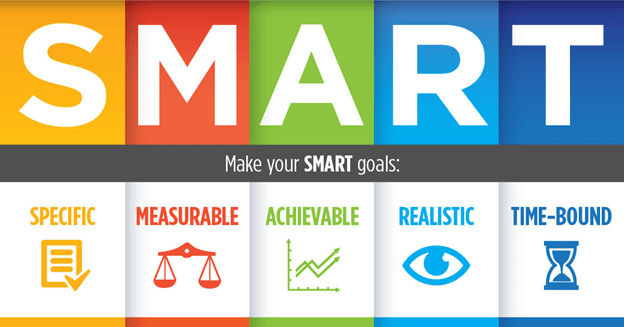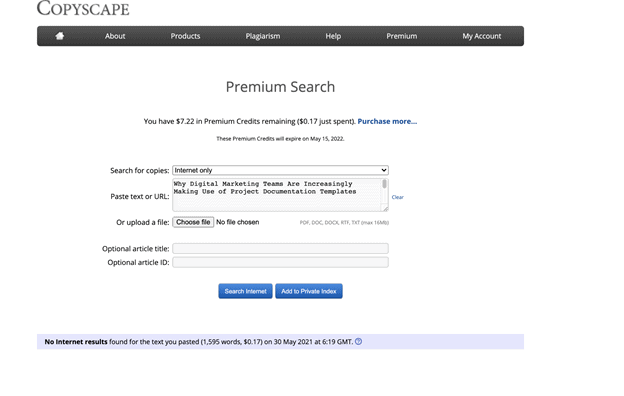“A project documentation template is a cosmos in chaos.”
Digital marketing is a hustle. What worked yesterday might not yield results today. You need to keep on testing and find new ideas to optimize and market your product. This makes experimentation a secret ingredient of the success of modern marketing.

But, here’s the thing.
On one hand, while your lean marketing approach brings exponential results, an unmanaged campaign, no matter how much potential it has, can ultimately end in a mess.
What follows is the wastage of valuable resources – time and money.
A project documentation template makes sure you have a clear understanding of what your target goals look like. It gives you a comprehensive understanding and insights on how to drive a campaign and document the final outcome of each campaign for optimum results.
In this post, we demystify the top benefits that a project documentation template can bring to your future marketing campaigns.
Top 7 Reasons Why Digital Marketing Teams Use Project Documentation Templates
A perfect project documentation example could be a project management template. It is a powerful productivity tool. Every alpha marketer understands the value it brings to their respective marketing teams.
Integrating a project documentation template not only optimizes active campaign execution time but creates opportunities for more efficient future campaigns. At its core, a project documentation template achieves one simplified and robust blueprint to streamline marketing operations and team efficiency.
Following are a few top benefits that a project documentation template brings to your marketing campaign immediately.
1. Create SMART goals
An ideal project documentation template will streamline your process readily.
As they say, “If you can’t measure it, you can’t improve it.”
A project documentation template gives structure and meaning to the specific needs of marketing teams. Having a template at the core of every marketing action makes your marketing SMART. Tasks that are specific, measurable, attainable, relevant, and time-constrained. This boosts efficient planning and smooth execution of the different jobs of the respective team members. Further, it can directly impact your deadlines, success metrics and help to create a forecast on where you can optimize the whole marketing operations program.
2. Improve return on investment (ROI)
A project documentation template has an immense impact on your marketing qualified lead (MQL) and sales qualified lead (SQL). By mapping your consumer behavior it can give you data-backed answers to all your key questions.
Disagree? Here’s how.
Knowing the ‘what’ is crucial in marketing but having the answer to the ‘why’ is where you champion the game. To truly understand the motivations of your ideal customer to buy your product, you need to tap into the psychographics, the emotional need of them.
Mapping the factual data of how your customer interacts and behaves in a particular channel with your brand can unlock your insight to design better programs targeted at each channel to optimize the ROI on every customer. This can potentially lead to a lower churn rate and higher retention.
3. Streamlined communication between team members
Every superstar marketing campaign starts and ends with a dream team. This makes collaboration and efficient communication critical for ultimate success. While you are scaling your marketing and operations, onboarding new team members at any stage of a marketing project is common.
But, think of the situation.
Every time your team has a new team member, you have to brief them with all the relevant details, facts, and approaches that your marketing team ventures into. It is not only time-consuming but strenuous. Isn’t it?
A project documentation template can save you from all of it without hampering the initial learning experience of your team members that are critical for their peak performance.
4. High performance
Project documentation gets the best out of each team member of your marketing operations. It helps you to create realistic targets and expectations from each team member to ultimately find ways to optimize their efforts in the long term.
Not convinced yet? Here’s how?
Let’s assume that the amount of work to be done versus the number of team members your marketing team has isn’t optimum. This means if you can’t expand team strength, you have to stretch deadline length. Or else, there are high chances of facing performance issues. A documentation template can improve this situation. You can allocate tasks by setting realistic deadlines that don’t compromise quality, tying your team together at the same time.
Reducing work redundancy, this blueprint focuses on bringing productivity onboard. With a documented plan handy with your team, prioritizing tasks based on job roles becomes really simple. What follows is efficiency in tasks from the micro to the macro level and more room for creativity. You can now focus on brainstorming and testing new ideas for your promotion and communication strategy.
5. Improve customer acquisition
Acquiring a new customer is probably the most considerable nervousness of any marketer. After all, gaining trust and building a rapport with a completely unknown person needs much more than just a value proposition.
But, here’s the thing. Documenting your marketing plan and the outcomes of each campaign can help to alleviate this problem by a notch.
Understand your audience, know the dynamics of their personality, how they feel, what they do what are their thoughts. These questions help you to get closer to the natural person. If you document the answers to these questions from an early stage, developing a proposal that your ideal customer cannot turn down will not be so difficult.
What’s more, you can do a comparative analysis of how your target consumer behavior is changing with time when you compare the key questions over years.
6. Improve customer retention
Customer acquisition is 5X more expensive than retaining a customer. This means if you have acquired a certain customer after all the hard work, not giving enough attention to them can create a leaky sales pipeline. Soon enough, it can potentially come to the point of breaking your business.
A project documentation template makes sure you know exactly where your program is failing. Documenting actionable metrics like churn rate, retention policies, and their outcomes in your document gives you insight into future critical marketing points. You can create programs to improve these business areas that can impact the overall revenue exponentially.
7. Optimize resources
There are two key roles of marketing, optimizing growth and optimizing marketing investment costs.
What if your marketing project documentation could help you in both?
While testing and experimentation give you data-centric results on the promotion strategies that impact maximum growth, the other half of the story talks about what you can leave in the trash box? Your documentation template can have a scorecard with a percentile of 10. You can use different metrics to map the efficacy of each campaign program you ran and are currently active on.
From here, you can filter out the least performing promotion campaigns that are consuming resources to direct the resources to the ones that are performing well. Along with that, you can design your future campaigns by ensuring you do not integrate the elements of your rejected campaigns.
How does your marketing team use a project documentation template? Best practices
A project documentation template can save you and your team a lot of valuable time.
Although, at the surface, it may look otherwise. To make sure this tool works at its optimum best, here are a few suggestions that your document foundation can rely upon. But before that, here’s a sneak peek at a project documentation example that works best for you.
- Keep the process agile: Your document should be lean. Document only actionable, high-value insights that you can use for future campaigns.
- Stick with simplicity: No matter how many years your team members have been working alongside you, a clear and concise document always gets the maximum work done. This creates clarity and comprehensibility in the process.
- Create separate documents for every campaign: Having a master campaign documentation book is a great way to analyze how your marketing efforts evolved over the years. More importantly, how your customer’s behavior changed. But this bulky book must not be part of your active day-to-day marketing documentation. Having an annual documentation book removes unnecessary confusion successfully.
- Always create backup files of your documents: Data is the oil of every business operation. This means you cannot afford to lose your valuable insights that you gathered along the years of hard work. But more than often, data losses occur in every team. Having a ritualistic document backup creation is therefore critical.
Parting Advice
Project documentation is a powerful tool in the digital marketing landscape. But, to ensure you can reap the benefits of this superstar tool, you need to keep your customer at the center.
You need to be as detailed and specific as possible while you document your marketing campaign but stay relevant to your end customers. Documenting vanity metrics like audience reach, likes, and impressions does not bring real value to your system. The value that a project documentation software gives is tied to boost your business goal. This brings you to the core part, documenting actionable, valuable data that can grow the business. If your document fails to answer these questions, you are losing money on the table.
But with the above guidelines, you can ensure your document is on the right track.
So, when you know why you should go for a project documentation guide, it is time to integrate it into your system.
Author bio:
Atreyee Chowdhury works full-time as a Learning Experience Designer and a part-time writer. She has helped many small and medium-scale businesses achieve their content marketing goals with her carefully crafted content that is both informative and engaging. She lives in Bangalore, India with her husband. In her free time, she loves to read, experiment with different cuisines, travel, and explore the latest content marketing and L&D trends. You can reach her on Linkedin or write to her at atreyee.c@gmail.com to discuss your content marketing plans and requirements.












0 Comments